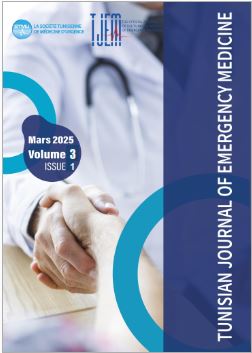Management of Bell palsy: our clinical practice guideline
- Authors
-
-
Samia Meherzi
ENT department, hospital of Sidi Bouzid, Sidi Bouzid, Tunisia , -
Rihab Omri
ENT department, hospital of Sidi Bouzid, Sidi Bouzid, Tunisia , -
Amin khbou
ENT department, hospital of Sidi Bouzid, Sidi Bouzid, Tunisia , -
Rabiaa Kaddechi
Emergency department, Sidi Bouzid Hospital, Sidi Bouzid, Tunisia , -
Afifa CHARFI
ENT department, hospital of Sidi Bouzid, Sidi Bouzid, Tunisia ,
-
- Keywords:
- Bell’s palsy, corticotherapy, facial nerve, physical therapy
- Abstract
-
Bell palsy is a frequent neurologic disorder defined by an acute mononeuropathy affecting the seventh cranial nerve presenting with ipsilateral facial weakness. It remains the most common etiology of facial nerve paralysis.
This is a retrospective study which identified 75 cases of Bell’s palsy from the medical records of the ENT department of Regional Hospital of Sidi Bouzid from January 2020 to December 2022.
Our series consisted of 17 children and 58 adults, with an average age of 37 years (range: 3 – 88 years). All patients consulted for an unilateral facial asymmetry. Initial assessment according to the House-and-Brackmann grading found 5 patients with grade I, 16 patients with grade II, 24 patients with grade III, 27 patients with grade IV, and 3 patients with grade V. Treatment was conducted in an outpatient setting in 64 patients. Hospitalization was required within 11 patients. Corticoids were initiated in 64 patients. Antiviral treatment, always in association with corticotherapy, was indicated within 21 patients, with a mean consultation delay of 3 days. All patients were given a vasodilator and vitamin therapy. Rehabilitation facial therapy was initiated in all cases, with a mean delay of 7 days. The objective of this study is to review the therapeutic management guideline of the patients presented with idiopathic facial nerve paralysis in our department in a comparison with the relevant literature.
- Downloads
- Published
- 31-03-2025
- Section
- Retrospective or cross-sectional study
- License
-
Copyright (c) 2025 Tunisian Journal of Emergency Medicine

This work is licensed under a Creative Commons Attribution-NonCommercial-ShareAlike 4.0 International License.


